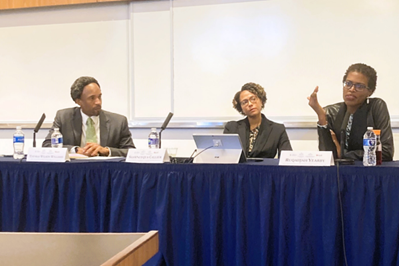Issues & Trends
The Future of Medical Technology Depends on Reexamining Our Notions of Race
December 04, 2023
As medical researchers employ artificial intelligence (AI) to synthesize vast amounts of data, many have raised concerns about perpetuating racial inequities when developing new medicines and treatments. In November, American University Washington College of Law (WCL) examined how our understanding of race may influence emerging medical technology to negatively impact health outcomes for individuals.
In November, American University Washington College of Law (WCL) examined how our understanding of race may influence emerging medical technology to negatively impact health outcomes for individuals.
In the panel “Genomics, AI, and the African Diaspora,” part of WCL’s Future of Health Care Series, assistant professor of law Thomas Wilson Williams (pictured, left) moderated the discussion between Shawneequa Callier (pictured, middle), associate professor of clinical research and leadership at George Washington University’s School of Medicine & Health Sciences, and Ruqaiijah Yearby, the Ohio State University Moritz College of Law’s Kara J. Trott Professor in Health Law. It quickly became apparent during the conversation that accurately and consistently defining fundamental concepts is at the heart of potential issues relating to the future of medical technology.
For example, defining AI proved problematic. As technology has evolved, definitions have changed to accommodate the developing understanding of AI’s underlying systems and potential uses. Williams defined AI as “the processing of large amounts of data” that include pattern recognition, components of decision making, machine learning, and algorithms. “It’s about how we can use large sets of data to crack into new spaces of knowledge,” he added.
Williams predicted that quantum computing, which has “the ability to process information at a much higher pace and in a much larger amount,” would fundamentally change how we relate to information.
The impending increase in processing capacity is particularly relevant in the area of genomics. “Genetics scrutinizes the functioning and composition of the single gene, while genomics is actually trying to understand all of these interactions,” Williams said.
Callier described how genetics might allow for the study and treatment of medical issues involving a single gene flaw, while genomics is necessary to address more complex illnesses like cancer. “The data that goes into genomic studies is limited … most of the work is done in European studies, so we know a lot about European populations, but there are very few studies coming out about Native American populations, people with ancestry from Africa, or elsewhere. The data is not enough, and that has complications for our work,” she said.
Where studies are done, they often filter results through the flawed lens of race. “There really is no genetic basis for race,” Yearby said. “And our social definitions are not very clear either.”
Callier agreed, pointing out the many changes in racial information collected in the census. “In the genetics field, they often refer to African ancestry,” Callier said. “A scientist will say, ‘I’m studying a subject with African ancestry, or I’m studying a European ancestry population, but there’s no biological basis.’” She said that the scientific community is currently moving away from the “continental model” of identification because of its lack of relevance.
“If Barack Obama went into a clinic, a doctor would treat him as Black and possibly believe that he is of West African ancestry,” Callier said, while his ancestors are from East Africa and England. “The same is true of Kamala Harris, who doctors might treat as Black and not take into account her Asian ancestry.”
To illustrate the potential pitfalls of race- and ancestry-based treatment, Callier cited the drug abacavir. Developed to treat HIV, the drug was known to cause an adverse reaction in individuals who have a specific allele, or variant gene form, that is more common in individuals of European ancestry. According to an article in the New England Journal of Medicine, this finding led some scientists to recommend screening for the allele in European populations but not others. However, substantial differences were seen in two African populations: The prevalence of the allele in the Kenyan Masai group was 13.6 percent (more than double that in European samples) but zero among the Yoruba in Nigeria.
“So, using the term ‘Black’ or ‘African ancestry’ in that context could have medical implications,” Callier said, “because the doctor wouldn’t necessarily know how they should go about prescribing drugs for the individual.” The U.S. Food and Drug Administration (FDA) recommends screening all groups for the allele before prescribing abacavir.
Another drug, BiDil, provides an additional example of the intersection between race and medical products. Developed by NitroMed Inc. and approved by the FDA as the first race-specific medication, it was marketed for use to combat heart failure among Black patients. “Lots of problems there,” Williams said.
Yearby pointed out NitroMed’s financial interest in the marketing of the drug, which she said was the product of an attempt to renew the patent protection for a lapsing medication through recombination with another drug. She said the company leveraged clinical results showing efficacy for Black patients to achieve its commercial goals while claiming to help the Black community.
“Companies can misuse this thought of health equity, and this thought of race, to say they are working to improve things, when their overall goal is just to make money and reinforce this notion of who is Black on a biological level, which is, again, not true,” Yearby said. “There is no biological link to race. It’s not even really social because we can’t define who is Black. It’s not really helpful in this context.”
Callier stressed that researchers and medical professionals are largely good-intentioned, but noted that the debate about the use of racial genetics is an ongoing one within the scientific community. She reiterated her own belief in the lack of biological basis for race. “The norm is for a person to have heterogeneous ancestry, and a person in Africa is more likely to be similar to someone in Europe than they are to be genetically similar to someone right next door,” she said.
Callier pointed out that the clinical trials of BiDil showed a 43 percent increase in the survival rate among patients identifying as Black, which justified its being brought to market. “My problem with BiDil is that we still don’t know today why 43 percent of people responded well to the drug. Where is the research into the biological basis for this beyond race?” she asked. Since inquiry stopped at race, valuable information is lost. “We’re not producing the data that we need so that we can use genetic data in the clinic,” she added.


